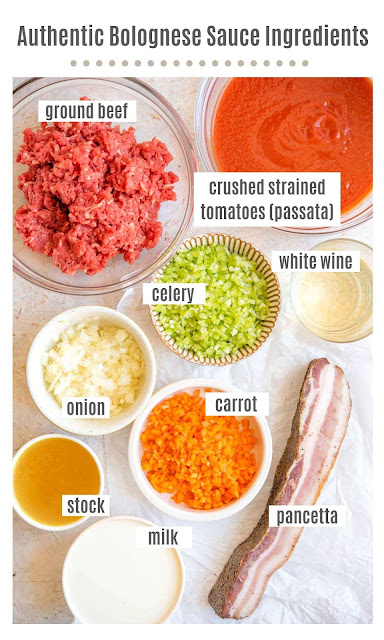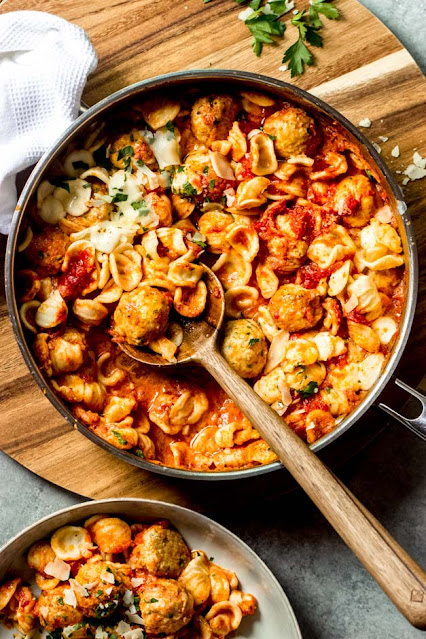Pecan Pesto Shells With Sausage
This rich sausage pesto pasta is a fast and simple weeknight meal that’s packed with flavor and can be prepared in under 30 minutes! Rigatoni is mixed with Italian sausage, pesto, Alfredo sauce, sun-dried tomatoes, fresh spinach, and a variety of herbs and spices.
If you enjoy recipes featuring Italian sausage pasta, make sure to try an Italian sausage tortellini soup, a dump-and-bake Italian sausage casserole, and this pasta with spinach and sausage as well!
Reasons You'll Appreciate this Recipe
Fast and Simple. This easy weeknight meal can be prepared in roughly 30 minutes and utilizes many pantry essentials.
Full of flavor. The blend of Italian sausage, cheese, Alfredo sauce, pesto, herbs, and spices makes each bite of this dish bursting with delightful taste. It’s rich, flavorful, and has a hint of heat!
Adaptable. There are numerous methods to adjust the recipe to match your tastes. For example, replace the spinach with chopped tomatoes or steamed broccoli. Consider using turkey sausage or chicken sausage, or transform it into a pasta bake featuring a buttery breadcrumb topping. Explore the Recipe Variations section below for additional ideas.
Components
Here’s a brief summary of the components required for a pot of pesto sausage pasta. As usual, detailed measurements and a sequential guide can be found in the printable recipe section at the end of the post.
Pasta: nearly any form is suitable! Rigatoni is a favorite of ours, yet we also enjoy penne, medium shells, rotini, and even spaghetti.
Olive oil: for sautéing the sausage, onion, and garlic.
Italian sausage: I buy a package of ground Italian sausage for convenience, but you can also get links and simply take the sausage out of the casings. Pork sausage, turkey sausage, or chicken sausage are all tasty.
Onion and garlic: to enhance taste.
Alfredo sauce: grab a jar of your preferred store-bought Alfredo for ease or prepare your own from scratch at home. This imparts a delightful creamy richness to the pasta.
Young spinach leaves: for health benefits and vibrancy.
Sundried tomatoes: purchase the tomatoes stored in oil, which are tender and moist.
Basil pesto sauce: either utilize a jar of store-bought pesto or prepare homemade pesto when fresh basil is available.
Parmesan cheese: contributes a savory, salty taste and smooth consistency. Grated fresh is optimal in this case.
Dried basil, dried parsley, and dried oregano: to enhance the Italian flavor even more. Fresh herbs are great when they can be found.
Crushed red pepper: to add some heat.
Kosher salt and black pepper: to elevate the tastes of the other components.
The Instructions
This tasty, child-approved pasta meal is prepared in roughly 30 minutes and could easily become one of your beloved recipes! You'll see thorough instructions in the recipe card below, but here’s the brief version:
Cook and strain the pasta, keeping a bit of the boiling water.
Cook the sausage, onion, and garlic until browned.
Mix the sausage blend with the pasta, pesto, Alfredo sauce, Parmesan cheese, vegetables, herbs, and additional spices.
Sauté on low heat, just until the spinach begins to wilt.
Dilute the sauce with a bit of the reserved pasta water, as required.
Dish into individual bowls and top with fresh herbs, red pepper flakes, or grated Parmesan cheese.
Ways to Serve
- Combine the rich sausage pesto pasta with any of these side dishes:
- Crispy Baguette, No-Knead Dutch Oven Loaf, or No-knead Skillet Focaccia
- Garlic Loaf or Bread Sticks
- Cranberry Muffins or Apple Muffins
- Pumpkin Loaf or Pumpkin Cupcakes
- Salad with Red Wine Vinaigrette, Mixed Greens dressed with Dijon Vinaigrette, Caesar Salad, or our beloved House Salad featuring Candied Pecans
- Southern Fried Apples, Baked Apple Wedges, or Apple Puree
- Oven-Baked Asparagus, Bacon-Wrapped Asparagus, or Stir-Fried Asparagus
- Amish Green Beans with Browned Butter or Southern-Style Green Beans.
- Parmesan-Crusted Cauliflower or Broccoli Roasted
- Bacon-Wrapped Brussels Sprouts or Roasted Root Veggies in the Oven
- Carrots with Brown Sugar Glaze
- Cabbage Roasted
Preparation and Storage Advice
Leftovers can be stored in an airtight container in the fridge for 3-4 days. I don't suggest freezing this recipe, as pasta often becomes mushy once thawed.
To warm the pasta, put it in a saucepan or skillet, cover it, and heat on low until the dish is at the preferred temperature. Incorporate additional pesto, Alfredo, or warm water to hydrate the pasta, if needed. Take caution not to heat or boil it excessively, or the pasta will become soggy. Individual servings can also be reheated in the microwave for approximately 1 minute.
Commonly Asked Questions
Which other meats pair nicely with this pesto pasta recipe? Try chicken, turkey, pork, shrimp, or salmon instead of Italian sausage.
What pasta shapes pair best with pesto? Nearly every type of pasta works wonderfully with pesto, as it adheres well to long shapes such as spaghetti, fettuccine, and linguine, as well as shorter forms featuring ridges and textures to capture all the flavor. We enjoy rigatoni, but penne, farfalle (bowties), medium shells, and fusilli or rotini are also great choices.
Why include pasta water in this dish? The water from pasta contains salt and starch. This water not only aids in thinning and loosening the pesto, but it also enhances flavor and improves the sauce's adherence to the pasta.
Variations in Recipes
Transform it into a pasta bake by placing the pasta mixture into a greased 2-quart baking dish. Finish with shredded mozzarella cheese or panko breadcrumbs that have been buttered. Cook, uncovered, in a 350°F oven until the topping turns golden brown, roughly 25 minutes.
Utilize nearly any type of pasta shape that you have available. We enjoy rigatoni, but other great choices are penne pasta, farfalle (bowties), medium shells, and fusilli or rotini. Shapes that are long like spaghetti, linguine, and fettuccine are also appealing.
Replace sausage with cooked shrimp, chicken, turkey, or salmon.
Experiment with different vegetables in place of the spinach or sun-dried tomatoes. Great options consist of steamed or boiled broccoli, sautéed mushrooms, zucchini, or bell peppers, a can of drained chopped tomatoes, and frozen peas.
If you have additional time, you might utilize homemade pesto or approximately 1 ¾ – 2 cups of homemade Alfredo.
Fresh basil, parsley, and oregano serve as excellent alternatives to dried herbs when accessible.
Incorporate a vibrant taste into the sauce by mixing in freshly grated lemon zest or lemon juice right before serving.
Pro Tips
- Season the pasta water generously with salt. This is the opportunity to flavor the noodles, and the salted water also enhances the sauce at the finish.
- Cook the pasta only until it reaches al dente (soft, yet still has a firm texture). It will keep cooking in the pot with the sausage and other components, and you don’t want to have mushy, overcooked noodles.
- Remember to save the starchy water from cooking the pasta, as you will need it to combine with the sauce later.
- For optimal flavor and texture, freshly-grated Parmesan cheese is recommended, but in a hurry, you can use a can of powdered, pre-grated Parmesan as a substitute.
Fixings
- 3/4 pound pasta shells or another short pasta
- 3 cups new level leaf parsley leaves
- 1/2 cup walnut parts
- 1/2 cup ground Parmesan (2 ounces), in addition to something else for serving
- legitimate salt and dark pepper
- 6 tablespoons olive oil
- 3/4 pound Italian hotdog, housings eliminated
Directions
Cook the pasta as per the bundle headings, holding ½ cup of the cooking water; channel the pasta and return it to the pot.Getting-enough-calcium.
Beat together the parsley, walnuts, Parmesan, ½ teaspoon salt, and ¼ teaspoon pepper in a food processor until finely cleaved. With the machine running, add 5 tablespoons of the oil and interaction until smooth.Kraft-bbq-meatloaf.
Heat the leftover tablespoon of oil in an enormous skillet over medium-high hotness. Add the hotdog and cook, separating it with a spoon, until carmelized, 6 to 8 minutes.
Add the pesto, hotdog, and ¼ cup of the held cooking water to the pasta and throw to cover (adding really cooking water on a case by case basis to relax the sauce). Sprinkle with Parmesan Enjoy it !!!My-favorite-pecan-pie.
Pecan Pesto Shells With Sausage VIDEO








